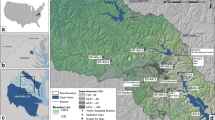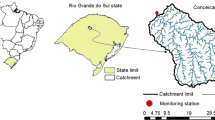Abstract
Soil erosion is a serious problem in areas with expanding construction, agricultural production, and improper storm water management. It is important to understand the major processes affecting sediment delivery to surficial water bodies in order to tailor effective mitigation and outreach activities. This study analyzes how naturally occurring and anthropogenic influences, such as urbanization and soil disturbance on steep slopes, are reflected in the amount of soil erosion and sediment delivery within sub-watershed-sized areas. In this study, two sub-watersheds of the Rappahannock River, Horsepen Run and Little Falls Run, were analyzed using the Revised Universal Soil Loss Equation (RUSLE) and a sediment delivery ratio (SDR) to estimate annual sediment flux rates. The RUSLE/SDR analyses for Horsepen Run and Little Falls Run predicted 298 Mg/y and 234 Mg/y, respectively, but nearly identical per-unit-area sediment flux rates of 0.15 Mg/ha/y and 0.18 Mg/ha/y. Suspended sediment sampling indicated greater amounts of sediment in Little Falls Run, which is most likely due to anthropogenic influences. Field analyses also suggest that all-terrain vehicle crossings represent the majority of sediment flux derived from forested areas of Horsepen Run. The combined RUSLE/SDR and field sampling data indicate that small-scale anthropogenic disturbances (ATV trails and construction sites) play a major role in overall sediment flux rates for both basins and that these sites must be properly accounted for when evaluating sediment flux rates at a sub-watershed scale.








Similar content being viewed by others
References
Berquist CR Jr (2003) Digital Representation of the 1993 Geologic Map of Virginia – Expanded Explanation. Commonwealth of Virginia Department of Mines, Minerals and Energy. Publication 174:61–63
Brady NC, Weil RR (2002) The Nature and Properties of Soils. Prentice Hall, New Jersey, 960 pp
Brush GS (1999) Human activities induced sediment problem: Ecological consequences of soil erosion and sedimentation. International Journal of Sediment Research 14:355–361
Campbell AH (1864) Map of Stafford County Virginia. Confederate Engineer Bureau, Richmond, Virginia
Carpenter JK, Watson AA, Odhiambo BK (2006) Spatial and 210Pb Analysis of Soil Erosion and Fluvial Sediment Deposition in two Sub-Watersheds of the Rappahannock River. Geological Society of America Abstracts with Programs 38:7 137 p
Commonwealth of Virginia (2005) Chesapeake Bay Nutrient and Sediment Reduction Tributary Strategy for Rappahannock River and Northern Neck Coastal Basins. Office of the Governor, Richmond, Virginia
Dauer DM, Lane MF, Llanaso RJ (2002) Development of Diagnostic Approaches to Determine Sources of Anthropogenic Stress Affecting Community Condition in the Chesapeake Bay. Department of Biological Sciences, Old Dominion University, Norfolk, VA
Elliot WJ (2000) Chapter 9: Roads and Other Corridors. In: Dissmeyer GE (ed) Drinking Water from Forests and Grasslands: A Synthesis of the Scientific Literature. U.S. Department of Agriculture, Forest Service Southern Research Station General Technical Report SRS-39. pp 85–100
Fu BJ, Zhao WW, Chen LD, Zhang QJ, Lü YH, Gulinck H, Poesen J (2005) Assessment of soil erosion at large watershed scale using RUSLE and GIS: A Case Study in Loess Plateau of China. Land Degradation and Development 16:73–85
Gallegos CL, Lewis EA, Kim HC (2006) Coupling Suspended Sediment Dynamics and Light Penetration in the Upper Chesapeake Bay. Smithsonian Environmental Research Center, Edgewater, MD, 36 pp
Griffin ML, Beasley DB, Fletcher JJ, Foster GR (1988) Estimating soil loss on topographically nonuniform field and farm units. Journal of Soil and Water Conservation 43:326–331
Heiri O, Lotter AF, Lemcke G (1999) Loss on ignition as a method for estimating organic and carbonate content in sediments: reproducibility and comparability of results. Journal of Paleolimnology 25:101–110
Isgrig D (1974) Soil Survey: Stafford and King George Counties, Virginia. U.S. Department of Agriculture Soil Conservation Service, 15–17, maps 41, 34, 28
Jen CH, Lin JC, Hsu ML, Petley DN (2006) Fluvial transportation and sedimentation of the Fu-shan small experimental catchments. Quaternary International 147:34–43
Jones DS, Kowalski DG, and Shaw RB (1996) Calculating Revised Universal Soil Loss Equation (RUSLE) Estimates on Department of Defense Lands: A Review of RUSLE Factors and U.S. Army Land Condition-Trend Analysis (LCTA) Data Gaps. CEMML Publications, TPS 96–8, 9 pp
Laflen JM, Flannagan DC, Engel BA (2004) Soil Erosion and Sediment Yield Prediction Accuracy Using WEPP. Journal of the American Water Resources Association 40:289–297
Langland M, and Cronin T (eds) (2003) A Summary Report of Sediment Processes in Chesapeake Bay and Watershed. Water-Resources Investigations Report 03-4123
Liu BY, Nearing MA, Shi PJ, Jia ZW (2000) Slope Length Effects on Soil Loss for Steep Slopes. Soil Science Society of America Journal 64:1759–1763
Lufafa A, Tenywas MM, Isabirye M, Majaliwa MJG, Woomer PL (2003) Prediction of soil erosion in a Lake Victoria basin catchment using GIS-based Universal Soil Loss mode. Agricultural Systems 76:883–894
Mahaney WM, Wardrop DH, Brooks RP (2005) Impacts of sedimentation and nitrogen enrichment on wetland plant community development. Plant Ecology 175:227–243
Mati BM, Morgan RPC, Gichuki FN, Quinton JN, Brewer TR, Liniger HP (2000) Assessment of Erosion Hazard with the USLE and GIS: A Case Study of the Upper Ewaso Ng’iro Northern Basin of Kenya. JAG 2(1):1–9
Mixon RB et al (1989) Geological Map and Generalized Cross Sections of the Coastal Plain and Adjacent Parts of the Piedmont, Virginia: Department of the Interior, U.S. Geological Survey
Mutua BM, Klik A (2005) Development of a Physically based Model for Estimation of Spatial Sediment Delivery Ratio for Large Remote Catchments. Journal of Spatial Hydrology 5:45–59
Odhiambo BK, Boss SK (2006) Watershed physiography, land use and sediment yield: Case study from NW Arkansas, USA. Journal of Spatial Hydrology 6:29–51
Odhiambo BK, Boss SK (2004) Integrated Eco Sounder, GPS, and GIS for Reservoir Sedimentation Studies: Examples from two Arkansas Lakes. Journal of American Water Resources Association 40:981–997
Orth RJ, Nowak JF, Wilcox DJ, Whiting JR, and Nagey LS (1998) Distribution of Submerged Aquatic Vegetation in the Chesapeake Bay and Tributaries and the Coastal Bays – 1998 College of William and Mary: School of Marine Science, Virginia Institute of Marine Science, Gloucester Point, VA, 150 pp
Pavlides L (1980) Revised nomenclature and stratigraphic relationships of the Fredericksburg Complex and Quantico Formation of the Virginia Piedmont. Geological Survey Professional Paper 1146:29 p
Rantz SE et al (1982) Measurement and computation of stream flow: Volume 1: Measurement of stage and discharge. U.S. Geological Survey Water Supply Paper 2175:313 pp
Renard KG, Foster GR, Weesies GA, McCool DK, and Yoder DC, coordinators (1997) Predicting Soil Erosion by Water: A Guide to Conservation Planning with the Revised Universal Soil Loss Equation (RUSLE). U.S. Department of Agriculture, Agriculture Handbook No. 703: 404 pp
Renfro GW (1975) Use of erosion equations and sediment delivery ratios for predicting sediment yield. Present and Prospective technology for Predicting Sediment Yields and Sources, Agricultural Resources Services ARS-S-40: 33–45
Restrepo JD, Syvitski JPM (2006) Assessing the Effect of Natural Controls and Land Use Change on Sediment Yield in a Major Andean River: The Magdalena Drainage Basin, Colombia. Ambio 35:65–74
Sharpley AN, McDowell RW, Weld JL, Kleinman PJA (2001) Assessing Site Vulnerability to Phosphorus Loss in an Agricultural Watershed. Journal of Environmental Quality 30:2026–2036
Tippett JP, Sharp K (eds) (2004) Stafford County, Virginia: Rappahannock Tributaries Watershed Planning Study. Prepared by Friends of the Rappahannock Inc., Fredericksburg, Virginia
Tippett JP, Sharp K (eds) (2002) Massaponax Creek Watershed Assessment. Prepared by Friends of the Rappahannock Inc., Fredericksburg, Virginia
USEPA (United States Environmental Protection Agency) (1997) Volunteer Stream Monitoring: A Methods Manual. EPA-841-B-97-003. Office of Water, 4503F, Washington, DC 20460
Verstraeten G, Poesen J (2002) Regional Scale Variability in Sediment and Nutrient Delivery from Small Agricultural Watersheds. Journal of Environmental Quality 31:870–879
Walling DE (2004) Using environmental radionuclides to trace sediment mobilization and delivery in river basins as an aid to catchment management. Proceedings of the Ninth International Symposium on River Sedimentation, October 18 – 21, 2004, Yichang, China
Ward AD, and Stanley WT (2004) Soil Conservation and Sediment Budgets. In: Environmental Hydrology: Second Edition: New York, Lewis Publishers, 255–271
Watson AA, Kiker JM, and Odhiambo BK (2007) Spatial Analysis and Radiogenic Characterization of Sediments to Identify Potential Pollutant Pathways in Remote Sub-watersheds of the Rappahannock River. Geological Society of America Abstracts with Programs, 39:2, 87 p
Wischmeier WH, and Smith DD (1978) Predicting Rainfall Erosion Losses: A Guide to Conservation Planning. U.S. Department of Agriculture. Agriculture Handbook No. 537: 58 pp
Wissmar RC, Timm RK, Logsdon MG (2004) Effects of Changing Forest and Impervious Land Covers on Discharge Characteristics of Watersheds. Environmental Management 34:91–98
Wood J (1820) The Wood Map of Virginia: Stafford County Virginia. Zapata, F. and E. Garcia-Agudo (2000) Future prospects for the 137Cs technique for estimating soil erosion and sediment rates. Acta Geologica hispanica 35:197–205
Acknowledgments
The authors would like to thank the University of Mary Washington for their financial support during the course of this project. The authors would also like to thank Dr. Grant Woodwell, Craig Hicks, Leigh Goldstein, and Matt Wilkinson for their support of our research efforts and Burt Harrison, Hunter Greenlaw, and Matt Small for access to sample sites within their property.
Author information
Authors and Affiliations
Corresponding author
Rights and permissions
About this article
Cite this article
Ricker, M.C., Odhiambo, B.K. & Church, J.M. Spatial Analysis of Soil Erosion and Sediment Fluxes: A Paired Watershed Study of Two Rappahannock River Tributaries, Stafford County, Virginia. Environmental Management 41, 766–778 (2008). https://doi.org/10.1007/s00267-008-9094-6
Published:
Issue Date:
DOI: https://doi.org/10.1007/s00267-008-9094-6




